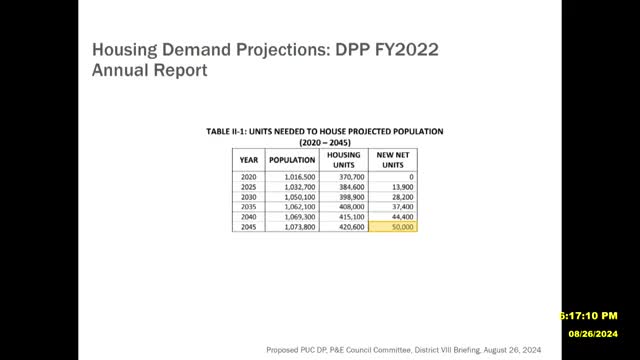Housing Crisis Looms as 50000 Units Needed by 2045
August 27, 2024 | Honolulu City, Honolulu County, Hawaii
This article was created by AI summarizing key points discussed. AI makes mistakes, so for full details and context, please refer to the video of the full meeting. Please report any errors so we can fix them. Report an error »

In a recent government meeting, officials discussed the projected housing needs for the island through the year 2045, revealing a significant demand for approximately 50,000 housing units. This estimate, derived from census-based projections, reflects the base need for housing across the entire island, rather than specific areas.
The Department of Planning and Permitting (DPP) emphasized that this projection is based on historical norms, suggesting that the housing market is expected to respond to population changes similarly to how it has in the past. The report indicated that if the market meets the projected demand, future populations would not face worse housing conditions than current or previous populations. Conversely, a failure to provide adequate housing could lead to increased challenges for residents.
Key factors influencing this housing demand include latent demand for multifamily and affordable housing, population growth projections, existing market conditions, and various infrastructure and environmental constraints. Additionally, the meeting highlighted the importance of known pipeline projects—those that have received permits but have yet to be constructed—as critical components in addressing the housing shortfall.
Officials underscored the necessity of proactive planning to ensure that the housing market can adequately respond to these projected needs, emphasizing the role of individual property owners and the condition of existing structures in shaping future housing availability.
The Department of Planning and Permitting (DPP) emphasized that this projection is based on historical norms, suggesting that the housing market is expected to respond to population changes similarly to how it has in the past. The report indicated that if the market meets the projected demand, future populations would not face worse housing conditions than current or previous populations. Conversely, a failure to provide adequate housing could lead to increased challenges for residents.
Key factors influencing this housing demand include latent demand for multifamily and affordable housing, population growth projections, existing market conditions, and various infrastructure and environmental constraints. Additionally, the meeting highlighted the importance of known pipeline projects—those that have received permits but have yet to be constructed—as critical components in addressing the housing shortfall.
Officials underscored the necessity of proactive planning to ensure that the housing market can adequately respond to these projected needs, emphasizing the role of individual property owners and the condition of existing structures in shaping future housing availability.
View full meeting
This article is based on a recent meeting—watch the full video and explore the complete transcript for deeper insights into the discussion.
View full meeting
